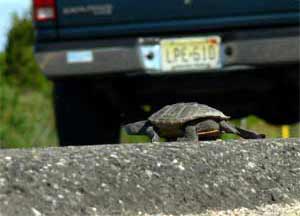 |
Abstracts of Papers
Presented by Wetlands Institute staff at the
Atlantic Estuarine Research Society Fall Meeting, October 5–7
The Community College of Baltimore, Baltimore, Maryland.
Searching for Diamondback Terrapin Roadkill “Hot Spots”
on the Cape May Peninsula (Southern New Jersey) Using Gis Mapping Techniques.
Maiko Yasu and Roger C. Wood

The Wetlands Institute, 1075 Stone Harbor Boulevard, Stone Harbor, NJ 08247, USA
 |


Adult female terrapin wandering onto a road
in search of suitable nesting habitat |
|
 |
Diamondback terrapins (Malaclemys terrapin) are only found in brackish water coastal salt marshes along the Atlantic and Gulf coasts of the United States. During the annual nesting season, hundreds of adult female terrapins are killed by motor vehicles on roads crossing and adjacent to salt marshes on the Cape May Peninsula of southernmost New Jersey. Attempts to mitigate this large-scale mortality include frequent daily road patrols throughout the nesting season (late May to mid-July) as well as the emplacement, on a limited basis, of roadside barrier fencing to prevent terrapins from wandering into the path of oncoming traffic. Each road patrol covers a distance of 15 miles. Fencing both sides of all the roads patrolled would therefore require some 30 miles of fencing, which would be prohibitively costly. Therefore, we have attempted to identify “hot spots” of terrapin road kills where barrier fencing could be selectively placed to have the greatest impact. GPS readings for all road kills were recorded over the past four nesting seasons (2003-2006). These were plotted to identify clusters of road kills. This information will be used in the future for the strategic placement of relatively short stretches of barrier fencing along roads frequented by nesting terrapins.
Tracking Northern Diamondback Terrapins (Malaclemys terrapin terrapin)
in a Southern New Jersey Salt Marsh Using Sonic Telemetry
Jacob R. Owens and Roger C. Wood

The Wetlands Institute, 1075 Stone Harbor Blvd., Stone Harbor, NJ, 08247
 |
 |


Arrow indicates transmitter
mounted on terrapin’s shell. |
|
Except for information about nesting activities, little is known about the behavior or ecology of northern diamondback terrapins. Thus it is difficult to estimate population sizes, a necessary first step for developing effective conservation methods for this stressed species. Diamondback terrapins are a cryptic species. Only females are seen on land during the early summer nesting season. Males never emerge onto land. In order to gain more knowledge about their detailed movements, 33 female diamondback terrapins (18 from 2005, 15 from 2006) found in the vicinity of the Wetlands Institute in Stone Harbor, NJ, were equipped with mobile transmitters (Vemco V9-2L-R04K coded pinger) and released back into the salt marsh. Ten stationary receivers (Vemco VR2), strategically placed throughout the marsh, picked up signals sent by the terrapin transmitters allowing us to record their movements. The objective of this study was to determine whether or not terrapins restrict their movements to specific areas within the salt marsh. Results so far show that there is considerable individual variation in the movements of different terrapins.
Return to Abstracts Index
|
 |
![]()
![]()

